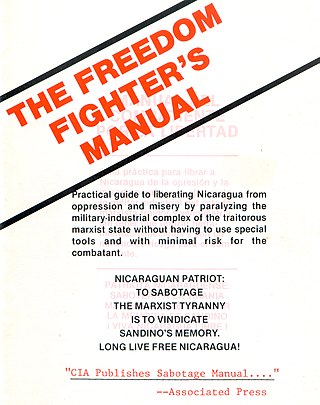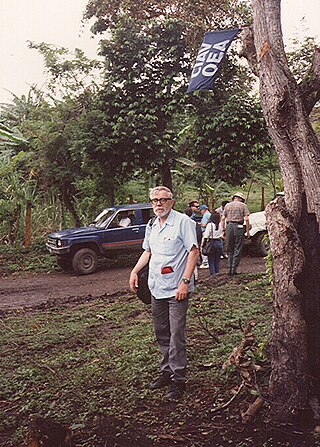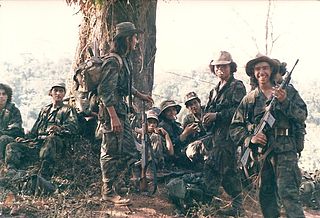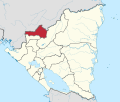
The Contras were the various U.S.-backed and funded right-wing rebel groups that were active from 1979 to 1990 in opposition to the Marxist Sandinista Junta of National Reconstruction Government in Nicaragua, which came to power in 1979 following the Nicaraguan Revolution. Among the separate contra groups, the Nicaraguan Democratic Force (FDN) emerged as the largest by far. In 1987, virtually all Contra organizations were united, at least nominally, into the Nicaraguan Resistance.

The Republic of Nicaragua v. The United States of America (1986) was a case where the International Court of Justice (ICJ) held that the U.S. had violated international law by supporting the Contras in their rebellion against the Sandinistas and by mining Nicaragua's harbors. The case was decided in favor of Nicaragua and against the United States with the awarding of reparations to Nicaragua.

Jalapa is a city in Guatemala. It is the capital of the department of Jalapa; it is also the municipal seat of that department's municipality of Jalapa.
The Boland Amendment is a term describing two U.S. legislative amendments between 1982 and 1984, both aimed at limiting U.S. government assistance to the Contras in Nicaragua. The first Boland Amendment was part of the House Appropriations Bill of 1982, which was attached as a rider to the Defense Appropriations Act of 1983, named for the Massachusetts Democrat, Representative Edward Boland, who authored it. The House of Representatives passed the Defense Appropriations Act 411–0 on December 8, 1982, and it was signed by President Ronald Reagan on December 21, 1982. The amendment outlawed U.S. assistance to the Contras for the purpose of overthrowing the Nicaraguan government, while allowing assistance for other purposes.

John Dimitri Negroponte is an American diplomat. He is currently a James R. Schlesinger Distinguished Professor at the Miller Center for Public Affairs at the University of Virginia. He is a former J.B. and Maurice C. Shapiro Professor of International Affairs at the George Washington University's Elliott School of International Affairs. Prior to this appointment, he served as a research fellow and lecturer in international affairs at Yale University's Jackson Institute for Global Affairs, United States Deputy Secretary of State (2007–2009), and the first ever Director of National Intelligence (2005–2007).

The Nicaraguan Revolution encompassed the rising opposition to the Somoza dictatorship in the 1960s and 1970s, the campaign led by the Sandinista National Liberation Front (FSLN) to oust the dictatorship in 1978–79, the subsequent efforts of the FSLN to govern Nicaragua from 1979 to 1990, and the Contra War, which was waged between the FSLN-led government of Nicaragua and the United States–backed Contras from 1981 to 1990. The revolution marked a significant period in the history of Nicaragua and revealed the country as one of the major proxy war battlegrounds of the Cold War, attracting much international attention.

Nueva Segovia is a department in Nicaragua. It covers an area of 3,491 km2 and has a population of 275,291. The capital is Ocotal.

Ocotal is the capital of the Nueva Segovia Department in Nicaragua, Central America and the municipal seat of Ocotal Municipality.

Municipalities are the second-level administrative divisions of Mexico, where the first-level administrative division is the state. They should not be confused with cities or towns that may share the same name as they are distinct entities and do not share geographical boundaries. As of January 2021, there are 2,454 municipalities in Mexico, excluding the 16 boroughs of Mexico City.
Somotillo is a town and a municipality in the Chinandega department of Nicaragua.

Somoto is a city and a municipality located in the hills of northern Nicaragua, and capital of the department of Madriz. It is around 20 km south-west of Ocotal and 51 km north-west of Estelí. It sits on the Pan-American Highway around 16 km from the Honduran border crossing at El Espino.
Masatepe Masatepe is one of the nine municipalities of the Department of Masaya in Nicaragua. It is located on the plateau of the villages 50 kilometers from Managua along the road to Masaya. It belongs to the tourist corridor of " Los Pueblos Blancos" on top of the coffee-producing Volcanic Plateau. The origin of the word "Masatepe" comes from Nahuatl Mazatl-tepec, «populated deer» or mazatl-tepetl, 'Deer Mountain'.
San Juan de Nicaragua, formerly known as San Juan del Norte or Greytown, is a town and municipality in the Río San Juan Department of Nicaragua.
Édgar Chamorro Coronel is an ousted leader of the Nicaraguan rebel Contras who later became a critic of the rebels and their Central Intelligence Agency sponsors, even cooperating with the Sandinista government in their World Court case, Nicaragua v. United States. He is a member of the prominent Chamorro family that provided five of Nicaragua's past presidents.

The Freedom Fighter's Manual is a fifteen-page propaganda booklet that was manufactured by the United States Central Intelligence Agency and airdropped over Nicaragua in 1983, with the stated goal of providing a "Practical guide to liberating Nicaragua from oppression and misery by paralyzing the military-industrial complex of the traitorous marxist state". The manual explains several methods by which the average citizen could cause civil disorder. A Contra fighter gave the manual to a U.S. reporter in Honduras in 1984.

The International Support and Verification Commission(Comisión Internacional de Apoyo y Verificación,CIAV) was created as a joint approach to repatriating the Contras by the secretaries-general of the United Nations and the Organization of American States on August 25, 1989 in support of the Esquipulas II Peace Plan. Its mandate was to assist in the voluntary demobilization, repatriation or resettlement of the Nicaraguan Resistance in Nicaragua and third countries as well as assistance in the voluntary demobilization of all persons involved in armed actions in all countries of the region. In practice the UN involvement in CIAV was relatively short, while the OAS participated in CIAV from the beginning and was deeply involved until 1993. In part this situation was due to the UN's emphasis on ONUCA, but it also reflected a geographic division of labor: the UN was assigned repatriation responsibilities in Honduras, Costa Rica and El Salvador. CIAV-OAS, on the other hand, was assigned geographic responsibilities for Nicaragua, which meant that they were responsible for every Contra and Contra family member who crossed the border into Nicaragua, and continued to be responsible for the support of most of them through 1993.
Operation Charly, was allegedly the code-name given to a program during the 1970s and 1980s undertaken by the junta in Argentina with the objective of providing military and counterinsurgency assistance to right-wing dictatorships and insurgents in Central America. According to Noam Chomsky, the operation was either headed by the Argentine military with the agreement of the United States Department of Defense, or was led by the US and used the Argentinians as a proxy.

Friendly Bilateral relations now exist between Nicaragua and the United States. However, in the 19th and 20th centuries, tensions were high and American intervention was frequent. In the 1980s Due to Red Scare paranoia and an attempt to put down socialism in the region, the U.S proceeded to wage an undeclared war against the left-wing Sandinista movement by funding the Contra groups until it was defeated in the election in 1990.

CIA activities in Nicaragua have been ongoing since the 1980s. The increasing influence gained by the Sandinista National Liberation Front, a left-wing and anti-imperialist political party in Nicaragua, led to a sharp decrease in Nicaragua–United States relations, particularly after the Nicaraguan Revolution. In 1981, President Ronald Reagan authorized the Central Intelligence Agency to support the Contras, a right-wing Nicaraguan political group to combat the influence held by the Sandinistas in the Nicaraguan government. Various anti-government rebels in Nicaragua were organized into the Nicaraguan Democratic Force, the first Contra group, at the behest of the CIA. The CIA also supplied the Contras with training and equipment, including materials related to torture and assassination. There have also been allegations that the CIA engaged in drug trafficking in Nicaragua.
In the U.S. political history of the 1980s, the Gang of Four refers to Bernard W. Aronson, Bruce P. Cameron, Robert S. Leiken, and Penn Kemble, four advocates of U.S. Congressional funding for the Nicaraguan Contras, who were engaged in an armed campaign in opposition to the Sandinista government, during the Reagan presidency. The four were prominent policy analysts and activists in the U.S. Democratic Party.















